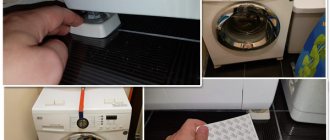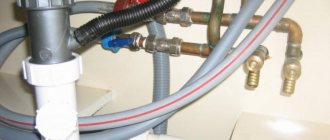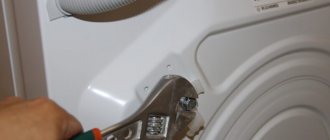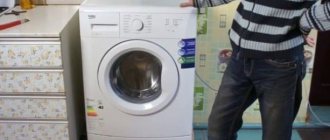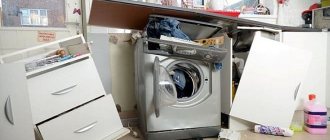- How to level a washing machine using a level
- How to level a washing machine without a level Method one - level from a plate
- Method two - smartphone application
- Adjusting the legs when setting the level
There are several factors that can cause a washing machine to jump or vibrate during the washing process: transport fasteners that have not been removed, drum overload, failed counterweight, bearings, or malfunction of other internal mechanisms.
However, the most common reason is poor installation. For quiet and safe washing, you should correctly place the washing machine on a flat horizontal surface, using a building level gauge or other available methods.
How to level a washing machine
There are several factors that can cause a washing machine to jump or vibrate during the washing process: transport fasteners that have not been removed, drum overload, failed counterweight, bearings, or malfunction of other internal mechanisms.
However, the most common reason is poor installation. For quiet and safe washing, you should correctly place the washing machine on a flat horizontal surface, using a building level gauge or other available methods.
How to level a washing machine using a level
This process consists of several stages. First, you need to make sure that the floor surface is level. This is determined using a special tool. The ideal coating is made of tiles, concrete or marble. If the site is uneven, in the slope area it is “built up” with substrates.
For mounting on a wooden floor, place a small piece of plywood under the structure, which will help balance the load on a shaky floor. If the boards are too old, it is recommended to disassemble them down to the concrete base. Then a “podium” of concrete mixture is poured, on which the unit will stand during use.
Before placing it on the selected area, a connection is made to communications: a water hose, an electrical outlet and a sewer drain. After installation, connecting will be problematic.
Next, twist the legs a little. After alignment with the level gauge, the racks are screwed in completely.
Then the device is placed on the prepared area. If checking with a tool reveals a tilt, the horizontal position of the washing machine is achieved by adjusting the corresponding support points. By turning the leg with the key included in the kit, you reduce the space between the floor and the structure at this point. And vice versa, by wrapping the stand, they raise the bottom of the washer.
How to level a washing machine without a level
Don’t despair if you don’t have a professional device at hand—a level. Correct installation of the washing machine is possible without it. Using various techniques and available means, you can achieve a horizontal position of the machine.
Method one:
You need to take a medium-sized plate, pour water into it and put it on the machine.
Determine the horizontality of the surface layer of water in the plate. Where the edge is lower, there is a roll.
We level the position of the device by adjusting the height of the support posts.
We make sure that there is no tilt by placing the plate of water on the machine again.
It is possible to see the tilt, if any, when rotating the plate 360 degrees. Instead of a plate, you can use a transparent glass. A mark is placed on its walls at a certain height. Water is poured to the marked border. The glass is installed on an automatic machine. Deviation from the permissible limit will indicate the presence of deviations in the position of the equipment.
Method two:
We download a special application for checking the level to your smartphone.
We install the mobile device with the program running on the washing machine.
In accordance with the test result, the “horizontalness” of household appliances or the presence of a slope is determined.
Next, if necessary, adjust the height of the support and level the location of the automatic machine.
To do this, you should shake the device in different directions. In the direction where the device falls, you need to adjust the supporting part, increasing its height. There is no need to immediately unscrew the entire length of the leg; this should be done gradually. This ensures the most stable location possible.
Other reasons for the “movement” of the SMA along the plane
If the adjustment is made correctly, and the jumping and shaking do not disappear, the cause may be the close proximity of large stationary objects - cabinets, walls. With slight vibration, which is natural, the SMA can hit an object and move from its established boundaries. Therefore, a gap of 5-10 cm is left between the wall and the device.
A smooth floor can also cause the washer to “move” around the kitchen or bathroom. In this case, it is worth purchasing a rubber mat 1-2 cm thick and placing it under the device.
If the above reasons are eliminated, but jumps and movements during washing remain, there may be a malfunction inside the machine. You can fix the problem yourself if you have certain knowledge and skills in this matter.
But it’s better not to take risks and entrust the solution to the problem to professionals. The experienced technicians of our specialized service center, located in Rostov-on-Don, will help you properly install or repair your washing machine.
Connection to water supply
First, let’s talk about what kind of water the washing machine is connected to. In general - to the cold. The water is then heated by heating elements as needed. Some owners, in order to save money, connect to hot water. This way, less energy is consumed when washing. But the savings are questionable - more hot water is wasted. If a meter is installed on the hot water supply, then it is cheaper to pay for electricity than for hot water. It is also worth considering that connecting a washing machine to hot water is not very good for laundry: the temperature causes the whites to curl and then not be washed well.
We were talking about ordinary washing machines, but there are models that connect to both hot and cold water. They have not one water inlet on the back wall, but two. In our country they are very rare - there is too little demand, and the prices for such equipment are much higher.
There are washing machines that connect to both hot and cold water
Now about the connection itself. The washing machine comes with a rubber hose, which is used to connect the washing machine to the water. Its length is 70-80 cm, which is not always enough. If necessary, you can buy a longer one in stores that sell plumbing fixtures (3 meters is not the limit, it seems).
This hose is screwed onto the corresponding outlet on the rear wall. There should be a sealing rubber gasket there, so there is no need to wind it up. Tighten the hose union nut (plastic) by hand; if you use wrenches, tighten it only half a turn. Not more.
Screw the inlet hose to a special outlet on the rear wall of the housing
The second end of the hose must be connected to the water supply system. If you have a free outlet somewhere that ends with a tap, great; if not, you need to make a tie-in.
If there is a free drainage of water, connecting the washing machine to the water supply is very simple - install a filter and a hose to it. All
The easiest way with plastic, polypropylene or metal-plastic pipes is to buy a tee (with one transition to metal), solder/install it. If the water supply is connected by a metal pipe, you will have to install the tee by welding.
In any case, a tap is installed after the tee. A simpler and cheaper one is a ball one. When installing it, you can wrap flax tow on the threads and lubricate it with paste.
After the tee, install a ball valve and connect the hose to it
There are also tees with taps for connecting washing machines and other household appliances. The same ball valve is installed in one of the outlets, but everything is done in one housing. It looks more compact, but if the tap malfunctions, you will have to change the entire tee, but it costs a decent amount.
Taps and tees for connecting household appliances
Sometimes it is recommended to install a filter before the tap. Of course, it won’t be superfluous, but if there is a filter at the entrance to the apartment or house, then there is no urgent need for it.
How to adjust the legs of a washing machine. How to level a washing machine
There are several factors that can cause a washing machine to jump or vibrate during the washing process: transport fasteners that have not been removed, drum overload, failed counterweight, bearings, or malfunction of other internal mechanisms. However, the most common reason is poor installation. For quiet and safe washing, you should correctly place the washing machine on a flat horizontal surface, using a building level gauge or other available methods.
Level installation of the washing machine is important
Depending on the brand, the SMA has 2 or 4 adjustable legs. To install the washing machine, you must select a location that fully meets the installation requirements. Do not place the unit close to walls or furniture. The surface on which the SMA will be placed must be flat, without depressions or protrusions. It is good if the base is tiled. A rigid base will allow the unit to be leveled without additional shock-absorbing cups, which will simplify the process.
If the SMA will be located in a room with a wooden floor, it is necessary to prepare a sheet of plywood 8-10 mm thick or OSB boards. Due to the fact that the floorboards have different densities and are not rigidly fixed along their entire length, vibration of the base will occur during operation of the unit. This will negatively affect the washing process, especially in the spin mode. An additional platform will allow you to evenly distribute the load over the floor surface.
The concrete base must be smooth and not crumble. If pieces break off when you tap the material, it is better to cover it with tiles or install another rigid stand. A poorly adjusted machine will vibrate and shift during operation, which can lead to the protection tripping or rapid bearing wear and failure.
At high rotation speeds, the drum may touch the surface of the tank and, if the latter is plastic, damage the walls.
A correctly aligned unit will ensure safe and correct operation throughout the entire period of operation.
Choosing a suitable location for the washing machine
An important step when installing the unit is choosing a suitable location. The placement method depends on the availability of free space, the location of communications, and the type of unit. The classic option is installation in the bathroom. There is access to cold water, sewerage and electricity. When space is limited, you can install the washing machine under the sink. When choosing a location for a top-loading unit, make sure there is enough room to open the lid.
The classic option for installing an automatic washing machine is the bathroom. There are the necessary communications and the ability to connect to the power grid.
Built-in appliances are becoming increasingly popular. Such a washing machine can be built into a column or placed in the kitchen under the countertop. This is an ideal option for small apartments with limited free space.
An unusual location for the unit is the hallway. But if there is enough space and communications can be made, then this option is quite convenient and ergonomic. You can also install a dryer here.
An important criterion when choosing a location is the presence of a hard and stable surface. The ideal option is bare concrete or floor tiles. When installed on a wooden floor, be prepared for strong vibration of the unit during washing and spinning.
Important external factors
When installing and connecting the device yourself, external factors such as the floor covering at the installation site and air temperature are taken into account.
Flooring
As mentioned above, the surface where the machine is placed must be durable.
We list the main types of floor coverings and their advantages and disadvantages from the point of view of installing a washing machine.
Tree
Not the best basis for installing the device. Firstly, wooden flooring is rarely perfectly level, secondly, it “plays” under load and, thirdly, it deteriorates when exposed to moisture.
If you still have to install the machine on a wooden floor, then it must first be strengthened to reduce vibration. A washing device with a depth of at least 45 cm is installed on the tree.
Laminate
Laminate flooring, like parquet boards, is laid on a waterproofing or soundproofing base. Such a substrate is elastic and will cause vibration of the floor covering during operation of the unit. In addition, parquet and laminate deteriorate when exposed to water.
Linoleum
Installing a washing machine on a wooden floor covered with linoleum is the least preferable option. It contains all the disadvantages: softness, slippery surface, hidden floor irregularities. When installing the device on such a surface, choose only a full-sized unit with a depth of 60 cm.
Ceramic tile
A ceramic tile floor is a good base for a washing machine. It is smooth, durable and well dampens vibration from a running drum.
The only drawback of this coating is its smoothness. During operation, the machine may slide on such a floor and shift. A special rubber mat or pads under the machine’s feet will help solve this problem. You can purchase such accessories at a hardware store.
Concrete
Concrete is perhaps the best option for installing a washing machine. It is hard, smooth and not at all slippery. A device of any depth is installed on such a coating.
Ambient temperature
Another important external factor is the air temperature where the machine is installed. It should not be below +10°C. You should not choose a place such as an unheated garage, loggia or veranda for the device. The problem is the lack of ventilation in such rooms and low temperatures in winter.
During operation, the washing machine generates heat. If the room is cold, moisture condenses on the inside of the machine, damaging the electronic components. Condensation also causes the appearance of black fungus and rust.
How to set it correctly
To install the washing machine level, you need to:
- Remove all transport bolts and check that the drum rotates easily.
- Loosen the locknuts on the legs using the wrench included in the kit.
- Fully tighten the supports.
- By adjusting the legs, achieve a stable position of the unit.
- Install a spirit level on the top cover of the SMA parallel to the control panel. If the air bubble of the device has moved to the right, then you need to adjust the legs on the left side, and vice versa. The machine is installed correctly when the ball is placed between the two middle marks.
- Position the level perpendicular to the previous position. You need to level the machine by twisting the front or rear legs.
Adjust the MCA until the device shows a horizontal position in both directions. Sometimes, when moving the machine across the floor, you can find a position in which adjustments are not required. This is possible if the base is made as level as possible. After you have finished installing the unit, you need to use a wrench to fix the nuts in the upper position, otherwise if vibration occurs, the adjustment will be disrupted. This can lead to independent movement and damage to the washing machine.
How to adjust the legs of a washing machine
Vibrations are a serious problem that can cause irreparable harm: they lead to damage to screws, bolts and other fasteners in the machine. Vibrations also cause frequent breakdowns of the plastic tank - if it bursts, water will flow. To prevent all these problems from happening, you need to tighten the legs on the washing machine.
Incorrect installation can not only damage the washing machine, but also damage surrounding objects. The machine may move due to strong vibrations.
Smooth and correct installation is ensured by special adjusting feet provided by SMA manufacturers.
To increase or decrease the height, screw the leg into or out of the body. These steps will help you level the machine without much effort.
There is no need to immediately twist the legs as much as possible.
Important points when adjusting the feet
When figuring out how to adjust the washing machine, you can tighten or unscrew the legs, setting it in a level position. To check the slope of the MCA, you will need to adjust the washing machine to the level. With its help you can measure deviations.
- Place the tool on the top of the washer body.
There are a lot of videos on the Internet on how to properly adjust the legs. To cope with this task, use one of these:
Common errors during connection and operation
We list the common mistakes made during installation and subsequent operation of a washing machine.
Incorrect installation of the drain hose
The end of the drain hose is installed at a certain height. The recommended height for each model is indicated in the instructions for the device. The general principle is that the highest point of installation of the hose should be slightly higher than the maximum water level in the machine tank.
Incorrect installation results in water leakage from the tank, a reverse siphon effect, and an unpleasant odor in the machine.
Network connection errors
A typical mistake is the use of non-standard electrical wiring (insufficient wire cross-section, single-layer insulation). This leads to overheating of electrical wiring, melting of insulation, short circuits, and electric shock.
Important. Improper connection of the device to the electrical network is not only dangerous to life and health, but can also cause malfunctions in the machine.
If the room was not originally designed for the installation of a washing machine, then the power supply is carried out using an individual (three-core) cable of the appropriate cross-section. The cable leads from the distribution panel with the installation of automatic switches rated for a current of at least 16 A.
Attention. The use of faulty or low-quality two-wire sockets and extension cords is unacceptable.
Incorrect water connection
The machine is connected to the water supply through autonomous taps located in an accessible place for operation. This makes it possible to quickly turn off the water if necessary.
Use of highly foaming powders
Excess foam fills the internal cavities of the machine, leading to malfunctions and breakdowns in the operation of electronic components.
Entry of foreign objects
Foreign objects falling into the machine along with laundry cause serious damage to internal parts, including engine failure. Therefore, before loading the laundry, carefully check it and remove all foreign objects from the pockets, as well as loose buttons and fasteners.
Incorrect switching of operating modes
The mode change is set after turning off the power and in a clockwise direction. Failure to comply with this requirement leads to damage to the control apparatus of the washing machine.
Failure to comply with loading standards
Overloading the machine and rolling the laundry into a lump causes increased vibration and rapid wear of the equipment. If a problem occurs, the machine is turned off, the laundry is redistributed and started again.
In addition, it is not recommended to leave machines that are more than 4-5 years old unattended and turned on. The likelihood of breakdowns and leaks at this “age” is very high.
This is interesting:
Small corner kitchen with washing machine: how to fit everything in.
How to wash kitchen towels with vegetable oil.
How to wash kitchen towels without boiling at home.
Level check
The correct installation of the SMA is checked during washing with a full load and maximum spin speed. An incorrectly aligned machine will manifest itself immediately after the drum begins to rotate, and maximum - in the centrifuge operating mode. To prevent strong vibration and movement on the floor, you need to adjust the unit at the moment the defect begins to appear. The adjustment is carried out on a de-energized SMA. There is no need to drain the water.
It is recommended to remove minor vibration by installing rubber pads under the supports. In addition, they will prevent the machine from moving on the tiles. During operation, it is necessary to periodically check the horizontal installation and the tightness of the locknuts. If any comments are found, they should be corrected.
Installation and adjustment rules
Before installing the feet, you should level the washing machine, otherwise the unit will continue to vibrate. For high-quality fixation, it is worth using a level that will help with alignment. You also need to prepare the surface, making it smooth and reliable, so the finishing material for the floor must be of high quality, strong, and durable.
Before installing the legs, it is worth connecting the unit to the water supply, as this will be problematic afterwards. Next, you need to slightly lift the “washing machine” on one side and fix the stand. After this, the legs are installed on all sides in the same way.
To adjust the stands, you should turn them counterclockwise, this way the devices will be lengthened or shortened.
You can find out how to install a washing machine to prevent it from jumping, below.
Connecting to the water supply
There are three ways to connect the washing machine to the water supply:
- through the coupling;
- through an angle tap;
- through a tee valve.
The choice of connection method to the water supply depends on the location of the connection. For example, if the kitchen sink faucet is connected to the water supply through a flexible hose, you can connect at the same point. To do this, you need to turn off the water, unscrew the hose from the outlet and connect the tee.
There are special tees for sale for washing machines: the size of the fitting in them corresponds to the size of the nut on the intake hose, and they are also equipped with shut-off valves. Next, the previously disconnected plumbing fixture and the intake hose of the machine are connected to the tee. The connection point can be sealed with FUM tape for reliability.
If this method is not suitable, you will have to connect to the water supply in a different way - cut into a pipe in the bathroom or kitchen. To do this, you will need a coupling with a sealing gasket, screwdrivers and a drill with a metal drill. The insert must be in an accessible place so that it is possible to open/shut off the water.
Step-by-step instructions on how to properly insert.
- Check the fastening of the water pipe and, if necessary, secure additionally with clamps or clips.
- Turn off the water.
- Secure the coupling with bolts or clamps to the pipe over the sealing gasket.
- Drill a hole in the pipe by inserting the drill through the coupling.
- Tighten the coupling, making sure that the gasket does not move.
- Attach the shut-off valve and the intake hose of the machine to the coupling.
When connecting with an extension, you need to make sure that the extension hose is located in a safe place - under the bathroom or furniture in the kitchen. It is also possible to mount it to the wall and then cover it with plasterboard.
Step-by-step installation of the machine
By correctly installing and connecting the washing machine, you will ensure quiet operation of the washing machine. Following the instructions, everyone can cope with the installation of the SM:
Analyzing how to balance your washing machine will ensure safe and long service life. The washing machine will work silently, without “running away” from its place. There is nothing easier than installing the machine in the bathroom, kitchen or utility room. Following the recommendations on how to adjust your washing machine is a guarantee that many problems will be avoided in the future.
How to install and adjust a washing machine yourself - 3 main rules
The time when housewives washed by hand has long been forgotten. Today, in any apartment, a washing machine is a common unit. It saves time spent on keeping clothes clean. At first, these were machines with only one washing mode, and they had to be squeezed out manually, rotating the rollers.
They were replaced by semi-automatic machines, in which the washing and spinning containers were isolated from each other, and the laundry had to be moved manually. Modern devices have one drum in which washing, rinsing and spinning take place. In addition, washing machines have quite complex electronic components that allow the implementation of several complex washing modes.
The washing machine drum rotates at high speed and has considerable weight. Users of household appliances often encounter problems when they overload it or the laundry is distributed unevenly during the spin cycle. The machine begins to vibrate, make noise, and sometimes even “dance” - move and jump.
Overloading the drum should be left to the owners’ conscience, but sometimes the machine “comes out” of the corner even without exceeding the permissible weight of the laundry. The reason is improper installation and adjustment of the washing machine. In order not to encounter problems and difficulties during operation in the future, you need to follow three main rules.
Rule 1 - The washing machine must be level
This requirement seems to be very simple, but in practice many people neglect it. If your bathroom floor is perfectly level, you're in luck. If the tiles are laid out of order or have played with time, then it is worth leveling the floor . In the case of unevenness on the starting concrete base, it will also need to be leveled using tile adhesive or a cement-sand mixture.
When the floor is in the desired condition, it’s time to install the machine. But when installed in the intended place, you can feel how the machine wobbles if you try to shake it. The fact is that the legs of the machine are bolts with fixing nuts and thick rubber pads on the thrust bearings.
If they are unscrewed to the wrong length, the machine will constantly move during operation. On the Internet you can find advice to limit yourself to rocking the machine and tighten the support in the area of the sagging corner. However, the human eye is deceiving, so follow the instructions.
Step-by-step instructions for adjusting the level of the washing machine
Step 1. Place the machine and check its position with a construction spirit level (level). This needs to be done four times : along all four edges of the top cover.
Step 2. If the air bubble deviates, the legs need to be unscrewed or, conversely, shortened. Lift the edge of the machine and place a wooden block under it. Unscrew the leg bolt the required number of turns, and then secure it with a clamping nut.
Step 3. Repeat the operation for all four legs. Then lower the machine to the floor and check the level again. If necessary, go over the problematic supports again.
Rule 2 - Connection to water supply
The wing nut on the hose for filling the washing machine with water exactly matches the thread of the mixer onto which the shower unit is screwed. However, such a connection is inconvenient: each time you have to unscrew the shower head and then put it back.
The machine must have a separate cold water tap with shut-off valves. This water collection point must be provided when renovating the bathroom and updating the plumbing.
Rule 3 - The washing machine must be drained through a siphon
Most washing units come with a special mount that allows you to bend the drain hose at an angle of 180 degrees . However, it is not intended to form a hook at the end of the hose so that it can hook onto the edge of the bathtub or toilet. It simply fixes the hose on the wall in a certain position.
When draining into the sewer, there must be a water seal . Otherwise, the unpleasant smell from the sewer will slowly seep into the machine and can spoil the smell of the laundry during washing. The hose can be placed on a special cap in the siphon under the sink or bathtub, or it can be connected to a hidden sewer siphon. In it, the ball is pressed by a spring and prevents the penetration of unpleasant odors.
Connection to water supply
Connecting water
If you follow the detailed instructions, connecting the automatic machine will not be difficult.
Rubber hoses are included with washing machines. They are usually of standard length, and very often they may not be enough for convenient installation of the machine. Therefore, alternatives are often used, such as:
- Buying a longer hose.
- Stationary water supply equipment.
For the first case, you just need to connect the hose to a water source
It is important to note that the hose must be laid in a place that is not subject to any mechanical damage. It can be covered with furniture
Also, do not install the hose under tension, otherwise it may be damaged by vibrations during washing. It is important not to skimp on this accessory, since the lifespan of the machine and the tightness of the connection to the water intake point depend on it.
If you use the second connection option, then you can lay a stationary water supply using copper or plastic pipes. Professionals do not recommend installing steel pipes, as in this case rust may accumulate in the machine elements and collect in the ferrous metal pipeline. In such a system, leaks cannot be allowed, so complete tightness must be ensured.
The same conditions apply for both cases:
- When connecting to a water supply, you need to install ball valves, as they allow you to shut off the water in a separate section of the system.
- It is advisable to install cleaning filters at the entrance to the machine so that purified water enters it. This will contribute to greater durability of the device.
It is important to connect the machine either to ready-made outlets, such as a mixer or drain tank, using tees, or before installation, specially install water outlets through the pipe
Preparatory stage
This stage is divided into preparing the machine itself for installation and preparing the selected location.
Preparing the device
If the car is new and just brought from the store, then first of all you need to unpack it. If the packaging is damaged, this may indicate damage to the machine itself.
Advice. When unpacking, try to remove the box undamaged. Subsequently, if a return is required, damage to the packaging may be grounds for refusal of a replacement. The packaging is stored during the entire warranty period.
After removing the packaging, the equipment is inspected for defects. Carefully check the completeness, checking the list in the passport.
After this, remove the bolts and fasteners installed for safe transportation. These parts are needed to secure the drum during transportation.
Important. Be sure to remove shipping fasteners before installation. If this is not done, the device will quickly fail. Moreover, the manufacturer's warranty will not apply in this case.
The location of the fasteners is indicated in the instructions. The holes for the transport bolts are usually closed with special plugs. Bolts are stored for the life of the equipment. They are reinstalled if the device needs to be transported.
Preparing the site
The main requirements for the surface at the location are strength and strictly horizontal location of the machine.
During operation, the device is constantly exposed to vibration from the centrifuge. Therefore, a surface that is not sufficiently rigid and strong will quickly wear out, creating a misalignment.
Preparation of engineering systems
To connect the washing machine you need the following communications:
Useful tips from experts
There are many options for how to connect a washing machine to the water supply, sewerage and electrical networks. Some of them are not correct and can shorten the life of the equipment and negatively affect your health. To prevent this from happening, we provide readers of Sam Electrica with some important tips:
- Under no circumstances connect the grounding contact to radiators or gas and water supply lines.
- Instead of fulenta, you can also use flax and paste, which are no less effective at blocking leakage.
- Few people know, but an automatic washing machine can be connected not only to the central water supply, but also to an ordinary barrel of water. All you need to do is place the tank at least 4 meters above the equipment itself. A distance of 1 meter will give a pressure of 0.1 atmosphere, while 0.4 atmosphere will be enough for the machine to operate even without a pump. This idea is often used in villages at the dacha, where the water supply is unstable or there is no running water at all (a well or a borehole).
- Align the building to building level. The slightest misalignment will cause vibration.
- Do not place pieces of rubber or linoleum under the feet. You only need to adjust the height by unscrewing/twisting them. Substrates will also negatively affect the vibration of equipment during centrifuge operation. Even if the floor is uneven, to prevent the washing machine from jumping, adjust the legs correctly.
- Do not throw away the shipping bolts, as... they may come in handy in the future (for example, if you move and take all your equipment to a new place of residence).
- When installing a temporary drain, keep in mind that the hose may fall out of the bathroom (which happens very often) and flood your neighbors. If even a short hose is not enough, it is better to go to a plumbing store for a new, longer one, and then correctly connect the washing machine to the water supply and drain.
That's all the technology for installing and connecting a washing machine with your own hands. We hope that the information was interesting and useful for you!
Related materials:
- How to connect a dishwasher
- Why is the washing machine noisy and how to fix it
- How to replace electrical wiring in a house?
Instructions for adjusting the legs of a washing machine to prevent them from jumping
The washing machine only jumps in the spin mode, whereas this does not happen during washing due to the peculiarities of this process. When spinning, the device creates oscillatory movements, which, turning into vibration, spread to the entire body.
Important! When installed correctly, the legs of the device absorb about 90% of vibrations and, by placing your hand, you can only feel small vibrations.
The main causes of strong vibration are:
- transport bolts that have not been removed, which transmit vibration, loosening the device;
- failure to remove the transported foam pallet;
- the device is not level;
- overweight when loading things - if the weight is too heavy, the drum bounces more, creating much stronger loads on the hinges, which leads to increased vibration;
- problem with drum bearings or shock absorbers.
New washing machines have problems with shipping accessories and improper installation. If a problem with vibration appears in an already installed device, there is a reason to send it for diagnostics or invite a technician.
Why does the washing machine jump during the spin cycle and what can be done about it?
First of all, check whether everything was done according to the instructions during installation. Often the machine jumps simply because the transportation anchors were not removed before use. They can be called transportation bolts, but this is not entirely correct - in addition to the bolts, there are other parts, but this is not significant. They are installed in the machine to rigidly fix the tank, which, as the name implies, protects the machine from damage during transportation. Sometimes during installation they forget to remove them or simply do not understand why they need to be removed, and this leads to strong vibration during the spin cycle. When the anchors are removed, the tank hangs freely on shock absorbers, which soften vibration. If you have no idea how to do this, it is better to call a professional. Readers who are fairly confident in their abilities can simply use the instructions - they describe in detail and with illustrations how to remove the anchors when installing a washing machine.
Another reason for a jumping car could be that the legs are not adjusted. This can be dangerous: if it is not completely level, some parts may touch each other and become damaged. Check the machine for unsteadiness by shaking it from side to side - the fact that it gives way clearly indicates that the legs are not adjusted correctly. It's not at all difficult to fix it yourself. Most often, the legs of the machine are simply tightened like bolts, so anyone can do it correctly. The best option for adjustment is to put a building level on the machine (if you don’t have one, you can use a saucer with water, but it will not give such accuracy). You must first place a building level parallel to the front (the door is located on it) and back walls of the machine, check the tilt in this plane and adjust. After that, place it parallel to the side walls, that is, perpendicular to the previous position, and do the same.
If the previous tips did not work, perhaps the reason is not the machine, but the unsuitable floor for it (too smooth, crooked or not strong enough). To fix this, you can buy a thick rubber mat, special rubber pads or suction cups. The pads will need to be glued on: check with the sellers on how to do this with the ones you purchased. You can probably find all this in any home goods store. In addition, the machine could simply move. Check to see if it is in contact with walls, pipes or other objects around it.
Still don't know why the washing machine is jumping? Some machines start to shake and make noise when they can't balance the laundry properly. It’s worth checking the instructions to see how much laundry they recommend loading. It is also recommended to add a couple of towels if you are washing one bulky item (for example, a jacket) so that the laundry is evenly distributed. When loading, try to distribute the items evenly throughout the drum and avoid washing too little or too much.
Shock absorber in a washing machine
Stage 7. Test activation
After completing all installation work, you need to check that the device is connected correctly by performing a test run. In this case, you do not need to load things into the drum, but carry out “sea trials” empty.
During the test run, you need to pay special attention to the following nuances:
- The speed at which water enters the tank. If it is too long, then perhaps the pressure in the supply hose is insufficient.
- There should be no leaks at the joints of hoses, pipes, fittings. If any are found, you need to tighten the nuts more tightly, or it is better to seal the joints with winding and seals.
- Water circulation during washing, rinsing and spinning should occur without problems or delays.
- During operation of the equipment, various extraneous sounds should not be heard. Vibrations and mechanical knocks may indicate an uneven base on which the machine is installed, or that all transport fixing elements have not been removed.
If any problems are found during the test run, they should be corrected promptly.
Step-by-step installation instructions
Installation of an automatic washing machine should begin with preparing the place where it will be installed. Models with horizontal loading require more space, while models with vertical loading require less.
The first mistake when creating an installation site is installing the device in a niche, which practically squeezes the machine on the sides. Such a solution can almost immediately lead to vibration problems, since the device still creates vibrations and this requires space - about 3-4 cm on each side, otherwise you can observe the problem of the device hitting the walls of the furniture.
Many craftsmen say that the minimum gap between furniture and appliances should be 1 cm, but this is not enough for most models.
Installation diagram: 1 - machine, 2 - connection to the electrical network, 3 - water supply pipe, 4 - sewer adapter
When choosing a place, you should pay attention to:
- convenient location of communications;
- presence of unevenness on the walls;
- the presence of objects on top at a height of less than 2-3 cm from the machine.
The basic installation diagram consists of the following steps:
- removal of all transport devices;
- connection to the sewerage system and water supply system - the main difficulty here is the selection of adapters for pipes; they should be selected according to the diameter of the machine pipe and pipes;
- connecting the adapter to the water supply system - it is better to install it at the junction of the tap with the water supply;
- installation of a sewer adapter;
- connection to sewerage and water supply systems;
- Level adjustment of the legs using a building level with pinpoint precision.
The biggest difficulty during installation is the type of floor covering, on which the “activity” of the machine depends. When installing on a tiled (tiled) or wooden floor, there should be no problems with installation, since such surfaces are smooth and hard, which is what is needed.
Important! Laminate and linoleum are softer coatings, so it is recommended to lay an additional hard layer on them in the form of chipboard.
Tools and materials
In addition to the installation location and the machine itself, it is also necessary to prepare tools. Would need:
- Flexible hose, 1.5 meters long. The hose is included with the machine, but it is usually short.
- Additional three-phase wires and socket, since it will need to be installed separately for the machine.
- Common tools: pliers, wire cutters, small hammer, nails, tape measure.
- A sewer siphon with three holes, if there is none and a permanent connection to the sewer is assumed.
- Hose fasteners and additional rubber gaskets.
- Tee and end valve for a water pipe.
- Plumbing sealant or FUM tape.
- Level.
After all the preparatory steps have been completed, you can begin connecting.
Choosing a location for installation
Is it time to upgrade your outdated washing machine? Or have you decided to treat yourself to such a new thing for the first time? In any case, before you go to the store, take a little time to consider some questions regarding where and how you will place your purchase.
The choice of location should be approached informally, since it will depend on where you place the new machine whether the purchase will become an excellent household assistant for you, or a cause of constantly arising problems. To determine the correct location for the washing machine, analyze the possible options.
- All necessary communications (cold water pipe, sewer pipe, separate outlet with grounding) must be within walking distance. No extensions, tees or additional drain hoses should be considered.
- The floor in the place where the machine is supposed to be installed must be perfectly level. Concrete or tile floors are ideal for installation. Small problems that may arise if you have a wooden floor can be easily fixed.
However, even a correctly selected location is not a guarantee that you can calm down. Having installed the brand new washing machine in its designated place in the bathroom or kitchen, proceed to the next step. It is necessary to ensure that during operation the machine does not jump and does not try to “run away” anywhere, showing a restive character.
To the sewer
If the hose is not lifted in this way, the water will pour out immediately after entering the machine.
The free end of the hose can be lowered into the toilet, bathtub or sink. This is not the best option because it is uncomfortable and the end may come off. Then the water will flood the floor, and maybe even reach the neighbors below.
There is a siphon under the sink. Remove the old siphon and install a special siphon with an additional hole for the hose.
- Make sure that the drain hose is not kinked. This makes it difficult for water to escape. Since the water is dirty, debris and dirt can accumulate at the bend.
- The hose must not be pulled. It should form a bend with a radius of 50 to 85 cm.
Recommendations for reducing vibration
There are several tips to reduce vibration:
- there is no need to overload the machine with things - modes with the maximum permissible weight are always described in detail in the instructions for the device;
- It is worth using anti-vibration stands and mats;
- It is worth checking the level of fixation of the machine and adjusting it;
- replacement of bearings and shock absorbers, when it comes to old equipment.
These tips will help reduce the noise level that occurs during spinning, but nothing more.
Anti-vibration stands and mats
Vibration reduction mats and stands are effective helpers in reducing vibration levels.
Vibration dampening mat
The mats are made of two layers - a rubber top layer to level the legs and a bottom foam layer to prevent vibration transfer to the floor. The stands are often rubber or consist of a mat with a special tray to dampen vibrations.
Useful articles, news and reviews on our Yandex Zen channel
Subscribe
Another reason for strong vibration
It happens that strong vibration is caused by unevenness of the supporting surface, which cannot be corrected. Or, after operating the machine for a long time, local wear has occurred on the supporting surface under the legs. As a result, the device becomes unbalanced during operation and the machine begins to jump and shake.
If adjusting the feet does not solve the problem, you can use an anti-vibration stand. It will reduce vibration and noise levels, and also prevent further damage to the flooring. This stand is made of polymer material and comes in different shapes and sizes. You can buy it at hardware stores.
How to adjust a washing machine yourself
- Tools.
- Dowels.
- Liquid Nails.
- Plywood.
First, you will need to check the surface on which you are going to install your washing machine. If the floor is uneven, then it doesn’t matter what kind of covering it has - tiled or concrete - the machine still won’t fit as it should. This means that even with slight vibration, the machine will still jump and slowly move from its original location. If this applies to your case, then you need to level the floor , and then you won’t even have to adjust the washing machine. If your floor surface is flat, then you should look at how the legs of the washing machine . To do this, you need to gently rock the machine back and forth. You can also tilt it slightly to the sides. This is necessary in order to understand which legs should be raised for adjustment.
Now let's move on to the process of regulating the washing machine. To do this, those legs that need to be lifted should be untwisted (or rather, the washer on them), and then we scroll the leg clockwise or counterclockwise. This is the adjustment process itself. To check the installation accuracy, use a building level . Ideally, the level bubble should be located centrally. To measure, it will be most convenient to place a level on the machine itself and make adjustments.
An additional device can be used to adjust and level certain types of machines. Take a sheet of plywood and cut out a base for the machine.
Next, you should attach it to the floor using dowels or liquid nails. What to do if you can’t get rid of vibration?
Destruction of internal components such as shock absorbers, dampers and counterweights usually causes the washer to shake and move during the spin cycle.
Only a specialist can accurately determine the malfunction and replace the part at the highest level, so if the vibration does not disappear after correctly following all the instructions, we strongly recommend that you seek advice from a specialist.
The washing machine “dances”: we adjust the legs on the automatic washing machine
A sad picture: the automatic washing machine does not stand in one place and vibrates. Moreover, it bounces during the spin cycle. If this happens, then with a high probability we can say that the unit is installed crookedly.
Some may think that the kitchen or bath floor is flat. But this is an illusion. There may still be some deviations.
How to level a washing machine? There is a method, a detailed description of which is given in the operating instructions. To do this, you just need to tighten or unscrew the legs of the washing machine.
To do everything correctly, you need to install a building level on the cover of the machine. The device will show you what needs to be done. That is, after this you can directly engage in adjustment.
We emphasize that the building level should be applied in several directions. Only then will it be possible to achieve almost complete compliance with the horizon. If you do everything correctly, the air bubble will be located strictly in the center.
There are machine models, in particular LG, whose instructions provide clear instructions that the device must be installed perfectly level. These instructions must not be ignored. Otherwise, get ready for a quick repair.
What can break if you install the machine incorrectly?
What breaks first? Mainly those parts that bear a large mechanical load.
— SHOCK ABSORBERS. They serve to dampen vibration of the machine legs during spin mode. When the machine is not installed level, the shock absorbers wear unevenly. And if the car is used for a long time, they may completely fail.
— BEARINGS. Even with a slight misalignment, an extra load is created on some group of bearings. With a small load this happens unnoticed. But in the case when the drum rotates at maximum speed, the imbalance becomes clearly noticeable.
And now a little about water stagnation. If the car is skewed, it creates a place where water stagnates. Unfortunately, the pump is not able to completely remove it. In such places, germs and bacteria usually begin to multiply. They often end up on clean things.
How to adjust a washing machine with your own hands
First of all, check the surface on which you intend to install the washing machine. When the floor is uneven, it does not matter what kind of covering it has - concrete or tile. The unit will still not be able to stand up as it should.
When the floor surface is flat, you need to look at how the legs of the washing machine stand. This is done simply. Gently rock the machine back and forth. After this, you can understand which legs need to be lifted for adjustment.
And now the process of regulating the washing machine itself. Unscrew the legs that need to be raised. That is, spin the washer on them. Scroll the leg clockwise or counterclockwise. The adjustment process comes down to this.
To check the accuracy of installation, use a building level. The level bubble should be in the center. To measure correctly, it is best to place the level on the machine itself and then adjust it.

